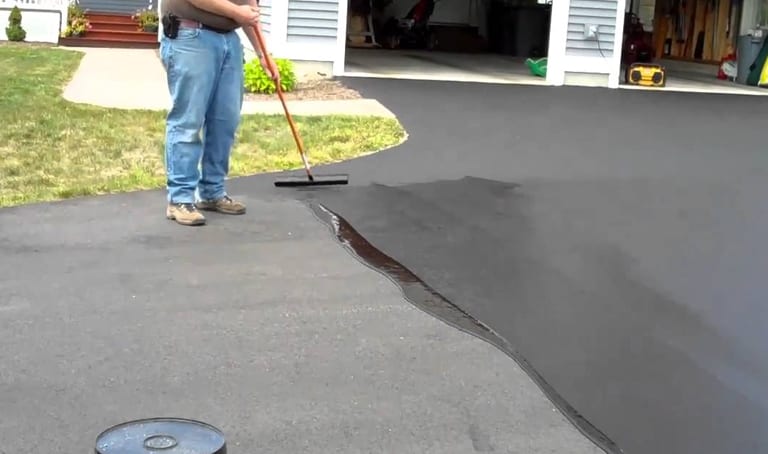Revitalize Your Building with Regrading and Asphalt Sealing Strategies
Revitalize Your Building with Regrading and Asphalt Sealing Strategies
Blog Article
Hot Mix Asphalt: A Lasting Remedy for Pavement
Warm Mix Asphalt (HMA) has become a leading lasting selection for pavement solutions, supplying a myriad of environmental advantages and cutting-edge technologies. Its capacity to lower and recycle materials energy intake presents a compelling case for its fostering in roadway construction projects. The lasting performance and durability of HMA make it a favored option for framework development. As the demand for eco-friendly building and construction techniques grows, checking out the subtleties of HMA's sustainability can give valuable understandings right into the future of sidewalk options.
Ecological Benefits of Hot Mix Asphalt

Additionally, Warm Mix Asphalt helps to mitigate city heat island effects. Its dark shade soaks up sunshine, lowering the amount of heat mirrored back right into the environment contrasted to lighter-colored pavements. This can reduce ambient temperatures in urban areas, decreasing the demand for cooling and ultimately reducing energy intake.
Furthermore, Warm Mix Asphalt adds to enhanced stormwater management. Its porous nature permits water to infiltrate the pavement and reenergize groundwater supplies, minimizing overflow and the threat of flooding. These ecological benefits make Warm Mix Asphalt a lasting choice for paving freeways and roads.
Energy Efficiency in HMA Production
Is energy efficiency an essential variable in the production of Warm Mix Asphalt (HMA)? Power plays a substantial duty in the production of HMA, influencing both expense and environmental sustainability. One key aspect of power effectiveness in HMA manufacturing is the use of warm mix asphalt (WMA) modern technologies.
Moreover, innovations in plant technologies have led to more energy-efficient HMA production processes. By optimizing energy use in HMA manufacturing, the market can decrease its carbon impact while preserving top notch sidewalk materials.
Recyclability of Warm Mix Asphalt
The recyclability of Warm Mix Asphalt (HMA) is a pivotal facet of its sustainability and lasting environmental influence. HMA is one of the most recycled products in the United States, with over 100 million heaps of recovered asphalt pavement (RAP) being recycled yearly in new sidewalk building. Reusing HMA offers numerous environmental benefits, such as reducing the demand for virgin materials, decreasing energy consumption during manufacturing, and decreasing the amount of waste sent out to landfills.
The process of recycling HMA involves milling the existing pavement, squashing it into smaller pieces, and blending it with new aggregate and asphalt binder to create a recycled mix. In general, the recyclability of HMA plays a considerable function in advertising sustainable methods within the pavement industry.

Long-Term Efficiency of HMA
Asphalt pavements show sturdiness and resilience over a prolonged duration, reflecting the long-lasting performance of Hot Mix Asphalt (HMA) The longevity of HMA can be credited to its capacity to endure rush hour loads, rough weather, and the effects of aging. Studies have actually revealed that properly designed and properly created HMA pavements can last for two decades or even more additional reading with routine maintenance. The trick to optimizing the long-lasting efficiency of HMA hinges on utilizing premium materials, adhering to best techniques in building, and applying effective upkeep approaches. Appropriate water drainage, regular assessments, and timely repair services are essential for protecting the architectural stability of HMA pavements with time. In addition, improvements in HMA modern technology, such as making use of polymer-modified binders and warm mix asphalt, have even more boosted the sturdiness and long life of HMA pavements. By prioritizing top quality construction and upkeep techniques, HMA proceeds to confirm itself as a affordable and lasting service for long-lasting sidewalk facilities.

HMA: Resilience and Sustainability
Showing both sturdiness and sustainability, Hot Mix Asphalt (HMA) has actually come to be a cornerstone in the construction of long-lasting sidewalk facilities - hot mix asphalt. HMA's durability comes from its capability to stand up to hefty tons, harsh weather condition problems, and high web traffic quantities, making it a reliable selection for streets, freeways, and airport terminal runways. The structure of HMA, which typically consists of aggregates, binder, and filler, plays an essential role in enhancing its long life and resistance to damage
Moreover, HMA's sustainability depends on its recyclability and energy-efficient production process. The ability to reuse recovered asphalt pavement (RAP) in brand-new HMA blends lowers the demand for virgin products i loved this and decreases the ecological effect of pavement building and construction and upkeep. In addition, the power performance of generating HMA lies in its lower blending temperatures contrasted to other pavement products, causing lowered power consumption and greenhouse gas exhausts.
Final Thought
To conclude, warm mix asphalt (HMA) provides a lasting service for pavement with its ecologically pleasant attributes. HMA's recyclability, power effectiveness in manufacturing, and lasting toughness make it an eco-friendly option for road building and construction. By saving natural deposits, reducing waste, and reducing greenhouse gas exhausts, HMA plays an essential function in advertising sustainability in facilities advancement. Its capacity to minimize metropolitan warm island impacts additionally underscores its value in developing resilient and eco mindful pavement systems.
HMA is one of the most recycled materials in the United States, with over 100 million lots of recovered asphalt pavement (RAP) being reused annually in new pavement building and construction.The process of reusing HMA involves crushing the existing pavement, squashing it right into smaller items, and blending it with brand-new accumulation and asphalt binder to develop a recycled mix.Asphalt pavements demonstrate durability and durability over a prolonged duration, showing the long-lasting efficiency of Hot Mix Asphalt (HMA) Furthermore, advancements in HMA technology, such as the use of polymer-modified binders and cozy mix asphalt, have further improved the sturdiness and long life of HMA sidewalks. The capacity to recycle redeemed asphalt read more pavement (RAP) in brand-new HMA blends lowers the need for virgin products and decreases the ecological effect of sidewalk building and maintenance.
Report this page